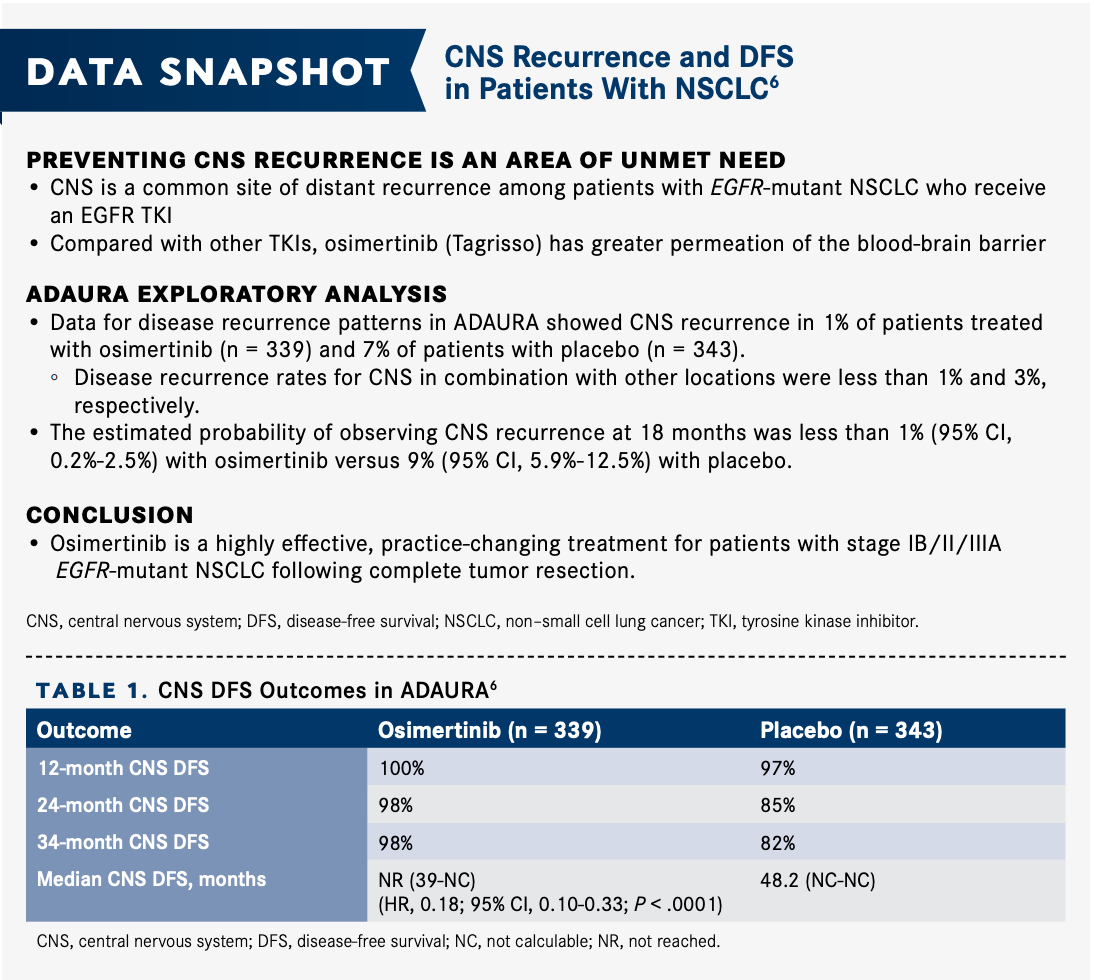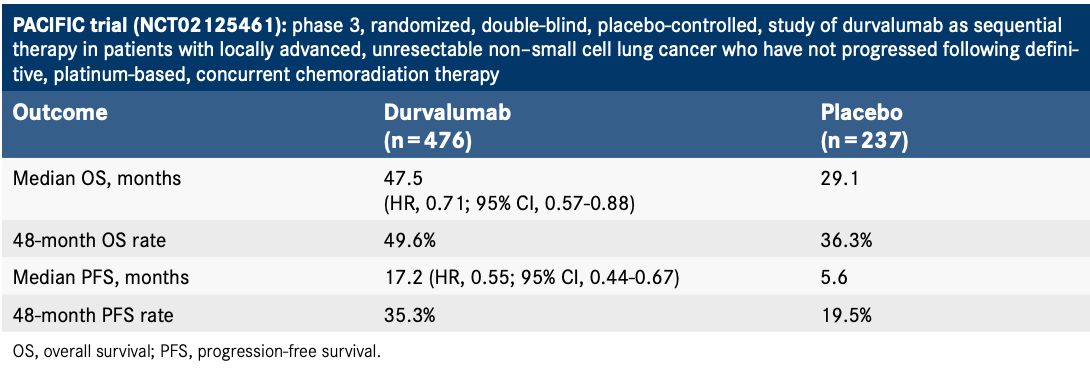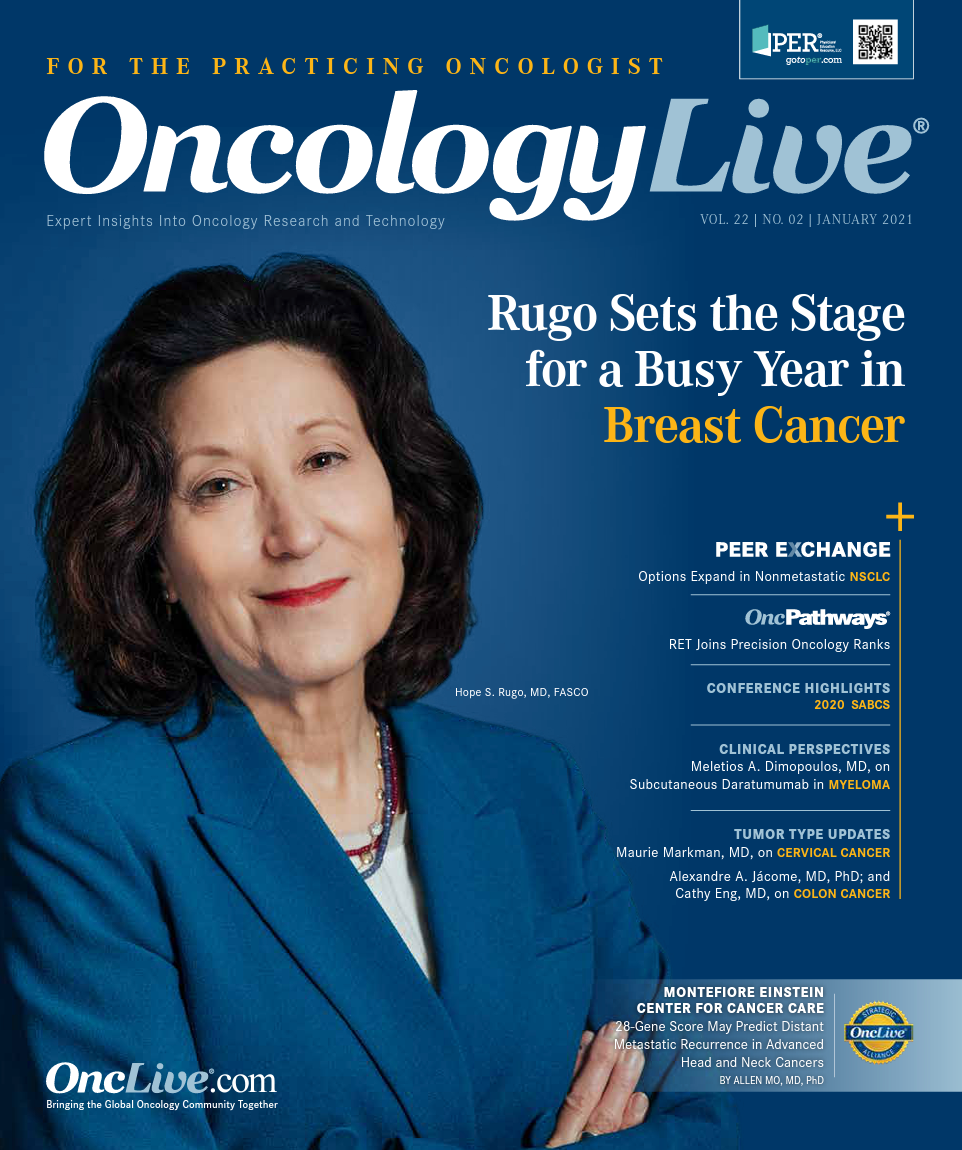Publication
Article
Systemic Treatment Options Expand in Nonmetastatic NSCLC
Author(s):
Although advances in diagnosis and treatment have led to improvements in overall survival for patients with NSCLC, low rates of survival outcomes are present even in those with nonmetastatic disease.
Jarushka Naidoo, MBBCh, MHS

Approximately 85% of all lung cancer diagnoses are categorized as non– small cell lung cancers (NSCLCs), which can include adenocarcinomas, large cell carcinomas, and squamous cell carcinomas.1 Although advances in diagnosis and treatment have led to improvements in overall survival (OS) for patients with NSCLC, low rates of survival outcomes are present even in those with nonmetastatic disease, with 54% with stage I, 35% with stage II, 10% to 15% with stage IIIA, and less than 5% with stage IIIB disease alive at 5 years.2 Subsequently, there has been a push to improve treatment for patients with nonmetastatic NSCLC—a setting where cure is far more likely—by better tailoring treatment to fit patients’ tumor profile, disease stage, and situation. “Once patients develop metastatic disease, treatment is not given with the intent of cure,” Jarushka Naidoo, MBBCh, MHS, said during a recent OncLive Peer Exchange®. “But we know that in the [nonmetastatic] setting, this is the goal. Let’s face it, that is the most meaningful, the most powerful goal we can ever achieve as cancer specialists.”
A panel of lung cancer experts from the United States and Europe convened to discuss several important studies presented during the European Society for Medical Oncology (ESMO) Virtual Congress 2020 that seek to address the unmet need in treating nonmetastatic NSCLC.
ADAURA: Adjuvant TKI for Early-Stage EGFR Mutation–Positive NSCLC
ADAURA (NCT02511106) is a double-blind, phase 3 trial that randomly assigned 682 patients with completely resected EGFR mutation–positive stage IB to IIIA NSCLC 1:1 to receive the third-generation EGFR tyrosine kinase inhibitor (TKI) osimertinib (Tagrisso) 80 mg orally once daily (n = 339) or placebo (n= 343) for 3 years.3 The primary end point was disease-free survival (DFS) in patients with stage II to IIIA disease per investigator assessment. Secondary end points included DFS in the overall patient population (stage IB to IIIA), OS, and safety.
The simple design of the trial and early discontinuation rates because of the efficacy observed in the investigational arm, which prevented OS data from being collected, were the cause of some concern for the panelists, however, the data may prove to be practice changing and they expressed readiness to adopt osimertinib for their patients with early-stage EGFR-mutated NSCLC. “Obviously, we’d love to have OS results,” Ticiana A. Leal, MD, said, noting that these results were still meaningful. “[OS] is the gold standard. If we’re not going to get that data, I’ll take DFS…with approval on the DFS end point.”
Ticiana A. Leal, MD

The FDA drew the same conclusion, and on December 18, 2020, the agency approved osimertinib as an adjuvant therapy after tumor resection in patients with NSCLC whose tumors have EGFR exon 19 deletions or exon 21 L858R mutations, as detected by an FDA-approved test.4 Osimertinib was previously approved for treatment-naïve patients with metastatic NSCLC harboring these same mutations as well as for those with metastatic EGFR T790M mutation–positive NSCLC that has progressed on or after EGFR TKI therapy.5 When deciding whether to use osimertinib in the adjuvant setting or wait until relapse, Naidoo said her inclination would be to use it as soon as possible. “If we have a shot at cure, therein lie the reasons why many would be open to the use of adjuvant osimertinib, even with an end point that isn’t necessarily considered the gold standard,” she said.
ADAURA showed significant difference in DFS between the osimertinib- and placebotreated patients well before the study’s planned 3-year mark. At 24 months, 90% of the patients with stage II to IIIA disease in the osimertinib group and 44% of those in the placebo group were alive and free of disease (HR for disease recurrence or death, 0.17; 99.06% CI, 0.11-0.26; P < .001).3 In the overall patient population, 89% in the osimertinib group and 52% in the placebo group were alive and disease-free at 24 months (HR for disease recurrence or death, 0.20; 99.12% CI, 0.14-0.30; P < .001).
The panelists noted that a common challenge in patients with certain lung cancers is their high risk of central nervous system (CNS) involvement (Snapshot, Table 16). “Brain metastases are a common outcome in patients with oncogene-addicted lung cancers— EGFR-mutant lung cancers and others. Patients can be very symptomatic. This can be a difficult complication of this disease. It is difficult to manage,” Naidoo said. She noted that a presentation at ESMO 2020 looked at the CNS disease recurrence data from ADAURA, an exploratory end point within the study.6 “Very interestingly, 45 patients had CNS events. Only 6 events were noted in the osimertinib arm compared with 39 events in the placebo arm. The median CNS DFS was not reached. It was 48.2 months for the placebo arm, and a very impressive KaplanMeier curve of the CNS DFS presented showed that the osimertinib arm nearly looked parallel, with a hazard ratio of 0.18. The idea that one could actually prevent CNS disease from occurring with adjuvant osimertinib is clinically important,” she said.

Although these data are encouraging, Naidoo indicated that there are some limitations that challenge their interpretation. Of importance, she said not all patients were required to have baseline imaging, making it unclear what their status was before treatment, and that imaging during the study could be computed tomography (CT) or magnetic resonance imaging (MRI). “As we know, CTs of the brain may miss about 10% of brain metastases compared with MRIs of the brain,” she explained. Despite these issues, she said the data were nevertheless “very impressive.”
Ravi Salgia, MD, PhD

With biomarker-driven treatments now approved for and showing benefit in nonmetastatic NSCLC, the panelists discussed the role of next-generation sequencing (NGS) for patients with these tumors. “I strongly believe that we should test everyone. This is really important if it can help us make a clinical decision—if we can make a potential predictive value,” Ravi Salgia, MD, PhD, said. The other panelists agreed and noted that information on concomitant mutations that NGS testing yields can further guide therapy, though the information sometimes adds challenges because a lot of questions remain on how some mutations may impact treatment, especially when they occur in certain combinations, and what their presence might mean for treatment sequencing.
Moderator Benjamin P. Levy, MD, provided one such real-world example. “I have a patient with resected ALK lung cancer. Should I be using alectinib [Alecensa] or osimertinib for EGFR? Again, we have a high rate of relapse. We have a known drug with great activity. Is this where we stop and pause or is there a role for adjuvant targeted therapies for other genotypes in the absence of data?” he asked.
Benjamin P. Levy, MD

The panelists used this opportunity to recommend that such patients be considered for the ongoing ALCHEMIST trial (NCT02194738), which is assessing whether adding targeted therapy based on patients’ tumor genetics will prevent cancer recurrence and improve OS. “This is an opportunity where we’re testing patients more commonly in the resected phase, and we can boost accrual to trials like ALCHEMIST,” Leal said.
IFCT-1601 IONSECO and PRINCEPS Trials: Neoadjuvant Immunotherapy for Early-Stage NSCLC
IFCT-1601 IONESCO (NCT03030131) and PRINCEPS (NCT02994576) assessed the PD-L1 inhibitors durvalumab (Imfinzi) and atezolizumab (Tecentriq), respectively, as neoadjuvant treatment options for patients with early-stage NSCLC.7,8 Somewhat disappointingly to the panelists, both demonstrated slightly less promising activity than earlier immunotherapy trials in this space.
In the IONESCO study, durvalumab was given on days 1, 15, and 29, with surgery undertaken 2 to 14 days after the last infusion.7 Among the 46 included patients, 41 (89.1%) had a complete resection, 2 (4.3%) had a microscopically incomplete resection, and 3 (6.5%) did not undergo surgery. “The partial response rate was 8.7%, with a major pathologic response rate of 18.6%... but the issue was [the trial] was stopped early because 9% [n = 4] had observed deaths,” Salgia said. He noted that these deaths were “most likely not related to the immune checkpoint inhibition but to comorbid disease.” The study authors similarly stated that patients’ comorbidities contributed to postoperative complications, rather than durvalumab exposure causing any life-threatening toxicities. The comorbidities observed in these patients included arterial hypertension, severe chronic obstructive pulmonary disease, diabetes mellitus, ischemic heart disease, and peripheral arterial disease.7 Overall, durvalumab was well tolerated, with no grade 3 to 5 adverse effects (AEs) observed.
In the PRINCEPS trial, 30 patients received 1 injection of atezolizumab and underwent surgery 4 weeks later.8 Use of atezolizumab did not impair surgery, and 4 patients (14%) had a major pathological response. Pathological responses did not correlate with RECIST 1.1 response rate or metabolic variations but were found to correlate with high PD-L1 expression. Again, treatment was generally well tolerated and there were no grade 4 or 5 AEs.
“My take-home message is that we’re seeing a similar trend like what we’ve seen in the metastatic setting. Single-agent immunotherapy has some response, but it’s pretty limited. When we combine that with chemotherapy, the response is higher, especially when we use the major pathologic response. When we combine with another IO [immuno-oncology] therapy—IO plus IO—it seems like the response is higher as well,” Jun Zhang, MD, PhD, said. Subsequently, he said he would probably favor exploring such approaches over monotherapy in the neoadjuvant setting but emphasized that caution is warranted because other trials have shown an increase in toxicities with combination approaches in this setting. As an example, he used the NADIM trial (NCT03081689), which assessed neoadjuvant paclitaxel, carboplatin, and nivolumab.9 In the study, 14 of 46 patients (30%) experienced grade 3 or higher treatment-related AEs. “Whether [such toxicities] would really delay surgery in the real world is another question,” he said.
Jun Zhang, MD, PhD

Salgia noted that cases of hyperprogression have also been observed in patients receiving immune checkpoint inhibitor and chemotherapy combinations. “We have to really consider whether we should do NGS on those patients up front to see if there’s a negative predictor, such as STK11 or MDM2 or something else, that will help us prevent that,” he said. Zhang agreed, noting that while the risk of hyperprogression occurring in clinical trials is rare, “we cannot really afford for any patient in our lives to get to hyperprogression.”
PACIFIC Trial: Immunotherapy After Chemoradiotherapy for Unresectable Stage III NSCLC
Finally, the panelists examined data from the PACIFIC trial (NCT02125461), which led to the FDA’s approval of durvalumab in 2018 for patients with unresectable stage III NSCLC whose disease has not progressed following concurrent platinum-based chemotherapy and radiation therapy.10 The PACIFIC trial randomly assigned 713 patients in a 2:1 ratio to durvalumab (n = 473) or matching placebo (n = 236) every 2 weeks for up to 12 months after completion of concurrent chemoradiation with at least 2 cycles of platinum-based chemotherapy.11 To date, data have shown a benefit in progression-free survival (PFS) and OS. After a median follow-up of 25.2 months, the 24-month OS rate was 66.3% in the durvalumab arm versus 55.6% in the placebo arm (two-sided P = .005), with an HR for death of 0.68 (99.73% CI, 0.47- 0.997; P = .0025). The median PFS was 17.2 months in the durvalumab arm and 5.6 months in the placebo arm (stratified HR for disease progression or death, 0.51; 95% CI, 0.41-0.63), whereas the median time to death or distant metastasis was 28.3 months in the durvalumab arm and 16.2 months in the placebo arm (stratified HR, 0.53; 95% CI, 0.41-0.68).11
During ESMO 2020, data were presented for the 4-year OS update, which had a median follow-up of 34 months (Table 212). “The good thing about having the updates is that it’s been reassuring to see that the data are holding up, and we’re seeing consistent improvements in PFS over time, as well as OS. This leads us to think that with the 5-year OS update, perhaps we’re actually going to be talking about cure rates,” Leal said.
Table 2. 4-Year Survival Update From the PACIFIC Trial12

The updated post-hoc analyses showed an estimated 4-year OS rate of 49.6% in the durvalumab arm versus 36.3% for the placebo arm after chemoradiotherapy. The median OS was 47.5 months for durvalumab versus 29.1 months for placebo. With a maximum treatment course of 1 year, an estimated 35.3% of patients treated with durvalumab had not progressed 4 years after enrollment versus 19.5% for placebo. “These are really impressive results. The tolerability of durvalumab has been well known to all of us, and it is well demonstrated in the trial. It really is a game changer,” Leal said.
Because the PACIFIC trial did not allow consolidation chemotherapy and one-third of patients received induction chemotherapy, which might not reflect real-life practice, Levy asked the panelists how they are putting the data into clinical practice, including which chemosensitization regimens they are using and whether they always start durvalumab right after radiation treatment is completed or give consolidation treatment.
Leal said that she may alter treatment in certain situations, including for those with severe neuropathy who cannot handle paclitaxel. “I want to make sure we don’t rock the boat during chemoradiation with extra toxicity. In general, I’ve preferred to use the carboplatin-paclitaxel regimen on a weekly basis during radiation.” As for consolidation chemotherapy, she said she has gotten away from using it. “We did that in select patients because we had intuitively thought that more is better. But, really, we have not seen that pan out in phase 3 clinical trials. So I don’t use consolidation chemotherapy. I am happy to let that go, and so are patients. That added toxicity might take patients away from being able to get to the consolidation with durvalumab, which is really the main goal,” she said.
Naidoo said she uses carboplatinpaclitaxel for many patients, but she also uses platinum-pemetrexed for those with adenocarcinoma because it is very well tolerated. “In terms of the timing of beginning durvalumab, a change in the protocol to allow for a wider window in commencing treatment changed our paradigm slightly, in requiring a scan to rule out progression. Beforehand, this was something we weren’t necessarily doing until later. The timing has become more of an issue and requires us to have seamless communication with our radiation oncology colleagues. That might change the workflow for many oncologists in settings where they don’t have real-time access to their radiation oncologists,” she said.
Salgia noted that a key issue will be determining what kind of durvalumab dosing and duration are truly needed to optimize outcomes while reducing toxicity risks. Currently, patients weighing at least 30 kg can receive durvalumab 10 mg/kg every 2 weeks or 1500 mg every 4 weeks, whereas those weighing less than 30 kg must receive the weight-based dosing.13 It is also unclear whether 1 year of treatment like in the PACIFIC trial is ideal or whether a shorter treatment course would yield comparable results or a longer treatment course would be superior in improving outcomes. “Those are all important questions as we go forward. But this is 1 of the first landmark studies that has revolutionized our practice,” he said.
References
- Molina JR, Yang P, Cassivi SD, Schild SE, Adjei AA. Non–small cell lung cancer: epidemiology, risk factors, treatment, and survivorship. Mayo Clin Proc. 2008;83(5):584-594. doi:10.4065/83.5.584
- Five-year survival rates. National Cancer Institute. Accessed December 28, 2020. https://training.seer.cancer.gov/lung/ intro/survival.html
- Wu YL, Tsuboi M, He J, et al; ADAURA Investigators. Osimertinib in resected EGFR-mutated non–small-cell lung cancer. N Engl J Med. 2020;383(18):1711-1723. doi:10.1056/NEJMoa2027071
- FDA approves osimertinib as adjuvant therapy for non-small cell lung cancer with EGFR mutations. FDA. December 18, 2020. Accessed December 28, 2020. https://bit.ly/2LUTAUA
- Tagrisso. Prescribing information. AstraZeneca Pharmaceuticals LP; 2020. Accessed December 28, 2020. https://www.accessdata.fda.gov/drugsatfda_docs/label/2020/208065s021lbl.pdf
- Tsuboi M, Wu YL, He J, et al. Osimertinib adjuvant therapy in patients with resected EGFR mutated NSCLC (ADAURA): CNS disease recurrence. Ann Oncol. 2020;31(suppl 4):S1177. doi:10.1016/j.annonc.2020.08.2279
- Wislez M, Mazières J, Lavolé A, et al. Neoadjuvant durvalumab in resectable non-small cell lung cancer (NSCLC): preliminary results from a multicenter study (IFCT-1601 IONESCO). Ann Oncol. 2020;31(suppl 4):S794. doi:10.1016/j. annonc.2020.08.1416
- Besse B, Adam J, Cozic N, et al. Neoadjuvant atezolizumab for resectable non-small cell lung cancer: results from the phase II PRINCEPS trial. Ann Oncol. 2020;31(suppl 4):S794-S795. doi:10.1016/j.annonc.2020.08.1417
- Provencio M, Nadal E, Insa A, et al. Neoadjuvant chemotherapy and nivolumab in resectable non-small-cell lung cancer (NADIM): an open-label, multicentre, single-arm, phase 2 trial. Lancet Oncol. 2020;21(11):1413-1422. doi:10.1016/ S1470-2045(20)30453-8
- FDA approves durvalumab after chemoradiation for unresectable stage III NSCLC. FDA. Updated February 20, 2018. Accessed December 28, 2020. https://bit.ly/3aBRPFU
- Antonia SJ, Villegas A, Daniel D, et al; PACIFIC Investigators. Overall survival with durvalumab after chemoradiotherapy in stage III NSCLC. N Engl J Med. 2018;379(24):2342-2350. doi:10.1056/NEJMoa1809697
- Faivre-Finn C, Vincente D, Kurata T, et al. Durvalumab after chemoradiotherapy in stage III NSCLC: 4-year survival update from the phase 3 PACIFIC trial. Ann Oncol. 2020;31(suppl 4):S1178-S1179. doi:10.1016/j.annonc.2020.08.2281
- Imfinzi. Prescribing information. AstraZeneca Pharmaceuticals LP; 2020. Accessed December 28, 2020. https://www.accessdata.fda.gov/drugsatfda_docs/label/2020/761069s023s024s025lbl.pdf










